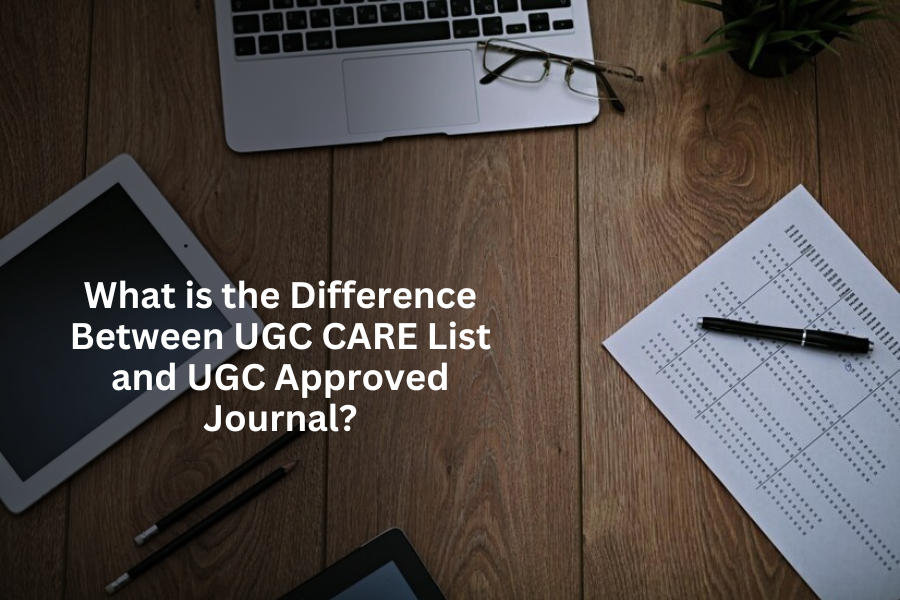Introduction
Academic publishing plays a crucial role in the dissemination of research findings and scholarly work. In India, the University Grants Commission (UGC) is the regulatory body that ensures the quality and credibility of academic journals. Two important terms frequently encountered by researchers and academicians are the UGC CARE List and UGC Approved Journals. While these terms are often used interchangeably, they have distinct meanings and implications. This article delves into their differences, significance, and impact on the academic community.
Understanding UGC CARE List
The UGC CARE List (Consortium for Academic and Research Ethics) was introduced by the University Grants Commission to promote high-quality research and prevent unethical publishing practices. It was established in 2019 as a replacement for the previous UGC Approved Journal list, which had many predatory and substandard journals.
Objectives of UGC CARE List
- Ensure Quality Control – The primary aim is to include only reputed and ethical journals.
- Prevent Predatory Publishing – Helps researchers avoid fake and non-credible journals.
- Enhance Research Visibility – Encourages publications in journals that have high impact and readership.
- Regular Updates – The list is periodically revised to maintain quality and remove questionable journals.
Classification of UGC CARE List
The UGC CARE List is divided into two groups:
- Group I: Journals found in UGC CARE Reference List of Quality Journals that are recommended by UGC CARE members.
- Group II: Journals indexed in globally recognized databases such as Scopus, Web of Science, and other high-ranking databases.
Researchers and academicians are advised to publish in journals included in these groups to maintain academic credibility and career advancement.
Understanding UGC Approved Journals
Before the UGC CARE List was introduced, the UGC Approved Journal list was the official reference for recognizing legitimate academic publications in India. This list included journals recommended by various committees and experts.
Key Features of UGC Approved Journals
- Previous Recognition – It was the earlier system used by UGC to recognize legitimate journals.
- No Regular Updates – Many journals continued to be listed despite their declining quality.
- Inclusion of Predatory Journals – Due to a lack of stringent checks, many fake or predatory journals found their way onto the list.
- Discontinued in 2019 – The UGC Approved Journal list was officially replaced by the UGC CARE List.
Key Differences Between UGC CARE List and UGC Approved Journals
| Feature | UGC CARE List | UGC Approved Journals |
| Establishment | 2019 | Before 2019 (discontinued) |
| Purpose | To ensure high-quality, ethical research publications | To list journals for academic and research purposes |
| Quality Check | Regularly updated and monitored | Lacked rigorous quality control |
| Inclusion Criteria | Must meet ethical and academic publishing standards | Earlier, some predatory journals were included |
| Categories | Group I and Group II | Single list without classification |
| Current Status | Active and recommended | Discontinued and not valid anymore |
Why is the UGC CARE List More Reliable?
- Stringent Selection Process – Journals are assessed based on strict ethical and quality guidelines.
- Regular Updates – The list is continuously revised to include high-quality journals and exclude substandard ones.
- Global Standards Alignment – It considers international indexing systems like Scopus and Web of Science.
- Avoids Predatory Journals – Helps researchers publish in legitimate journals to maintain academic integrity.
Impact on Researchers and Academia
1. For Researchers
- Publishing in a UGC CARE-listed journal enhances academic credibility and recognition.
- It helps in career advancement, funding opportunities, and meeting institutional requirements.
- Protects researchers from predatory journals that may demand high publication fees without quality assurance.
2. For Institutions
- Encourages faculty and students to focus on ethical and high-impact research publications.
- Ensures that institutional research output meets global academic standards.
- Enhances the institution’s reputation and ranking by promoting quality publications.
3. For Policy Makers
- Helps in framing better academic policies related to research and funding.
- Supports the development of strong research infrastructure within academic institutions.
- Ensures that India’s research output is recognized at a global level.
How to Check if a Journal is in the UGC CARE List?
Researchers can verify whether a journal is listed in the UGC CARE List by following these steps:
- Visit the official UGC CARE website.
- Navigate to the ‘Search Journals’ section.
- Enter the journal title or ISSN number.
- Check if the journal appears in Group I or Group II.
If a journal is not found in the list, it is advisable not to publish in that journal, as it may not be recognized for academic or career advancement purposes.
Conclusion
The UGC CARE List is the new and improved version of what was previously known as the UGC Approved Journal list. While the older list had flaws and included many predatory journals, the UGC CARE List ensures that only quality and ethical journals are recommended for research publications. Researchers and academicians should always refer to the latest UGC CARE List before choosing a journal for publication to ensure that their work is recognized and valued in the academic community.
By understanding the differences and implications, researchers can make informed choices, contributing to the integrity and advancement of academic research in India.



